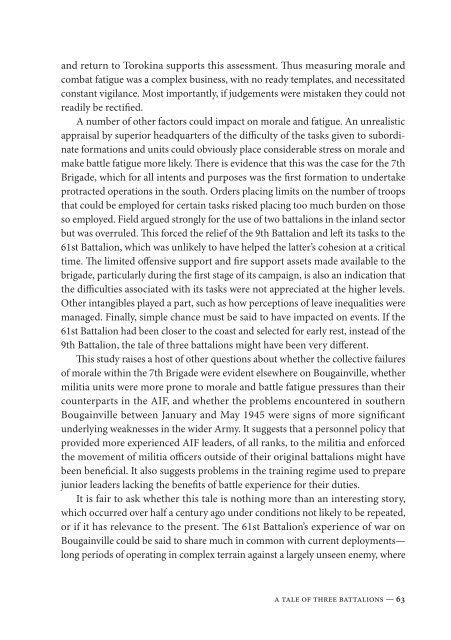View the pdf - Australian Army
View the pdf - Australian Army
View the pdf - Australian Army
You also want an ePaper? Increase the reach of your titles
YUMPU automatically turns print PDFs into web optimized ePapers that Google loves.
and return to Torokina supports this assessment. Thus measuring morale andcombat fatigue was a complex business, with no ready templates, and necessitatedconstant vigilance. Most importantly, if judgements were mistaken <strong>the</strong>y could notreadily be rectified.A number of o<strong>the</strong>r factors could impact on morale and fatigue. An unrealisticappraisal by superior headquarters of <strong>the</strong> difficulty of <strong>the</strong> tasks given to subordinateformations and units could obviously place considerable stress on morale andmake battle fatigue more likely. There is evidence that this was <strong>the</strong> case for <strong>the</strong> 7thBrigade, which for all intents and purposes was <strong>the</strong> first formation to undertakeprotracted operations in <strong>the</strong> south. Orders placing limits on <strong>the</strong> number of troopsthat could be employed for certain tasks risked placing too much burden on thoseso employed. Field argued strongly for <strong>the</strong> use of two battalions in <strong>the</strong> inland sectorbut was overruled. This forced <strong>the</strong> relief of <strong>the</strong> 9th Battalion and left its tasks to <strong>the</strong>61st Battalion, which was unlikely to have helped <strong>the</strong> latter’s cohesion at a criticaltime. The limited offensive support and fire support assets made available to <strong>the</strong>brigade, particularly during <strong>the</strong> first stage of its campaign, is also an indication that<strong>the</strong> difficulties associated with its tasks were not appreciated at <strong>the</strong> higher levels.O<strong>the</strong>r intangibles played a part, such as how perceptions of leave inequalities weremanaged. Finally, simple chance must be said to have impacted on events. If <strong>the</strong>61st Battalion had been closer to <strong>the</strong> coast and selected for early rest, instead of <strong>the</strong>9th Battalion, <strong>the</strong> tale of three battalions might have been very different.This study raises a host of o<strong>the</strong>r questions about whe<strong>the</strong>r <strong>the</strong> collective failuresof morale within <strong>the</strong> 7th Brigade were evident elsewhere on Bougainville, whe<strong>the</strong>rmilitia units were more prone to morale and battle fatigue pressures than <strong>the</strong>ircounterparts in <strong>the</strong> AIF, and whe<strong>the</strong>r <strong>the</strong> problems encountered in sou<strong>the</strong>rnBougainville between January and May 1945 were signs of more significantunderlying weaknesses in <strong>the</strong> wider <strong>Army</strong>. It suggests that a personnel policy thatprovided more experienced AIF leaders, of all ranks, to <strong>the</strong> militia and enforced<strong>the</strong> movement of militia officers outside of <strong>the</strong>ir original battalions might havebeen beneficial. It also suggests problems in <strong>the</strong> training regime used to preparejunior leaders lacking <strong>the</strong> benefits of battle experience for <strong>the</strong>ir duties.It is fair to ask whe<strong>the</strong>r this tale is nothing more than an interesting story,which occurred over half a century ago under conditions not likely to be repeated,or if it has relevance to <strong>the</strong> present. The 61st Battalion’s experience of war onBougainville could be said to share much in common with current deployments—long periods of operating in complex terrain against a largely unseen enemy, whereA tale of three battalions — 63
















